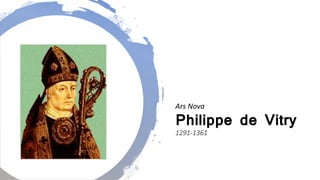
Ch. 3 music in the 14th century
- 1. Philippe de Vitry 1291-1361 Ars Nova
- 2. Ars Nova • Condemned by Pope John XXII (and lots of others) showing the church’s ambivalence about using music in worship • Chief characteristic: enhanced rhythmic flexibility • Codified the use of mensuration signs • System would stay in effect through Renaissance and develop into the modern system in the 17th century
- 3. Le Roman de Fauvel • Ars nova’s best example: Le Roman de Fauvel • Includes both short monophonic pieces and large-scale polyphonic motets • ~1316 – satirical allegory – comments on dangers of corrupt and incompetent government ministers • Untexted tenor is structured as an isorhythm
- 4. Isorhythm • Term coined in the 20th century to describe the technique • Isorhythmic tenor is based on a fixed rhythmic and melodic pattern repeated at least once (usually more often) • 14th century isorhythms are much longer, became the preferred structure of this century’s motet • Le Roman de Fauvel and Guillaume de Machaut’s motets are all isorhythmic This Photo by Unknown Author is licensed under CC BY-SA
- 5. Isorhythmic tenor: The rhythm is called talea The melody is called its color
- 6. This Photo by Unknown Author is licensed under CC BY-SA-NC
- 7. Polyphonic settings of the Mass Ordinary In the 14th century, polyphony occurred in pairs (Gloria and Credo, or Sanctus and Agnus Dei)
- 8. Polyphonic settings of the mass ordinary: Messe de Nostre Dame, Mass of Tournai
- 9. Messe de Nostre Dame Composed early 1360s The only 14th-century polyphonic setting of the complete Mass Ordinary known to have been written by a specific composer All movements are based on a plainchant version of the Mass Ordinary Rise of the composer: by this time, more and more artists were associating their names with their creations
- 10. French Secular Song • Formes fixes – “fixed forms” are • Ballade • Virelai • Rondeau • These are both poetic and musical forms at the same time, with their own patterns of rhyme and musical repetition, with at least one refrain
- 11. Ballade • Usually has 3 strophes (verses) of 7-8 lines, the last is always a refrain (chorus) • First section is always repeated; second section is sometimes repeated: music is AAB, or AABB • Ballades are the most melismatic of all the formes fixes used in 14-century France; the upper voice is rhythmically most active
- 12. Virelai • The refrain is sung at the beginning and end of each strophe • Set in a syllabic fashion, tend to be monophonic with a soloist possibly over other instruments • Could also be performed instrumentally, with no text/voice at all
- 13. Rondeau • 8 lines of text with scheme ABaAabAB • Machaut’s Ma fin est mon commencement employs retrograde inversion (the cantus, or highest solo line, sung backward from beginning to end, is exactly the same as what the tenor sings forward from beginning to end) • Spiritual roots: the idea that beginnings and endings are one and the same deeply rooted in Christian theology, connecting death to physical and spiritual rebirth
- 14. Ars subtilior • Latin, “the more subtle art” • Compositions written to show music not only as an art of sound, but also as an art of contemplation that could engage and challenge the INTELLECT as well as the soul
- 15. Italian trecento • Three vocal forms: • Ballata – like the French virelai – smooth melodic lines that project the text syllabically • Caccia – “chase” – texts usually are about hunting, street vendors • Madrigal – began as literary form of 2-3 strophes with a rhythmically contrasting ritornello at the very end – for 2 voices with tenor which can be either sung or played instrumentally
- 16. ENGLAND • Songs are roughly contemporary with the great English poet Geoffrey Chaucer (1342-1400) – Canterbury Tales are full of musical imagery and references to music making • Sumer is icumen in – oldest known song written in English, c. 1250 • Used 3rd and 6th intervals more than on the Continent, where mostly 4th and 5th intervals were used
- 17. Instrumental Music • Instrumental music entertained guests at banquets, accompanied dancers, signaled troops into battle • Some church patriarchs felt music without text to be transient and empty • Instruments played an important role in worship, as medieval churches are adorned with carved images showing them
- 18. Summary of Part 1, Chapter 3 – Medieval Era • Music varied widely from France, Italy, and England – all developed their own idioms and genres • Isorhythm and polytextual motets gradually declined • Music grew more towards simplified and homogeneous textures and carefully controlled dissonance
Editor's Notes
- QuickStarter has created an outline to help you get started on your presentation. Some slides include information here in the notes to provide additional topics for you to research. More key facts: Top Songs: Almifonis melus/Rosa sine culpe spina, Aman novi probatur/Heu, fortuna subdola, Apta caro/Flos virginum, Colla iugo subdere/Bona condit, Cum statua Nabucodanosor/Hugo, Hugo, princeps invidie, Douce pleysence/Garison selon nature, Firmissime fidem/Adesto Sancta Trinitas, Floret cum vana gloria/Florens vigor, Flos ortus/Celsa cedrus, Impudenter circumvivi/Virtutibus laudabilis, In virtute/Decens carmen, O canenda vulgo/Rex quem metrorum, Petre Clemens/Lugientium siccentur, Se je chant, Servant regem/O Phillippe, Trahunt in precipicia/Quasi non ministerium/Ve qui gregi, Tribum que non abhorruit/Quoniam secta latronum, Tuba sacre fidei/In arboris, Vos quid admiramini/Gratissima virginis species
- Consider talking about: Works attributed to Vitry on strong historical evidence Works attributed to Vitry on a combination of weaker historical evidence and stylistic grounds Works attributed to Vitry on stylistic grounds alone (not widely accepted)